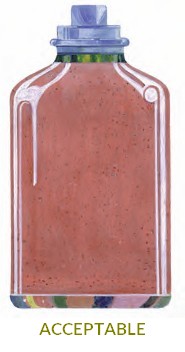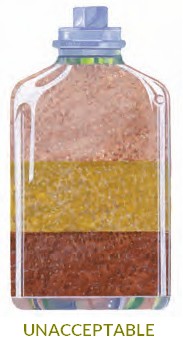Resources
Sprayer Calibration Guide
Testing for Compatibility




Physical incompatibility may occur in tank mixtures with water or fluid fertilizers. Fluid fertilizers vary in density, viscosity, and nutrient analysis and will react differently than water in tank-mixture combinations. Because manufacturers may change formulations from time to time, compatibility of tank-mix combinations needs to be verified on a small scale before the tank-mixtures are prepared for an actual application.
Physical incompatibility of tank-mixtures will result in the formulation of gels, creams, oil scums, or other precipitates which may or may not be sprayable. If the incompatible tank-mixture is applied to the turf, an uneven spray distribution may occur and result in unacceptable performance. If the incompatible tank-mixture is not sprayable, then costly cleanup and disposal problems occur.
Using the correct proportions of each component of the tank-mixture, a small quantity (approximately 24 fluid ounces) is prepared and examined for physical incompatibility. One procedure is to add 16 fluid ounces of water or diluted fertilizer solutions to a quart jar. The products are generally added in the following sequence: 1) dispersible granules, 2) wettable powders, 3) flowable suspensions, 4) liquid iron products, 5) soluble concentrates, 6) emulsifiable concentrates, 7) surfactants, 8) drift retardants and 9) indicator dyes.
Jar Test Procedures
Physical incompatibility may occur in tank mixtures with water or fluid fertilizers. Fluid fertilizers vary in density, viscosity, and nutrient analysis and will react differently than water in tank-mixture combinations. Because manufacturers may change formulations from time to time, compatibility of tank-mix combinations needs to be verified on a small scale before the tank-mixtures are prepared for an actual application.
Often a pre-dilution or pre-slurry of the wettable powder, flowable suspensions and emulsifiable concentrates with water greatly improves the compatibility. The jar, no more than three-quarters full, is then capped, shaken for 15 seconds, then left to stand for 24 hours.
Following the setting period, the mixture is observed for precipitates, gels, flakes, sludge or oil layers. If no problems are observed, the mixture is satisfactory. If a precipitate forms, but is easily dispersed with shaking, it is satisfactory to use with adequate agitation. If the precipitation is severe, then the mixture should be retested by changing the sequence or order of addition of the components.
This test offers an approach for predicting the end result of tank-mixtures. It is up to the applicator to follow label directions and pretest for compatibility on a small scale before the spray solution is prepared in the sprayer.



